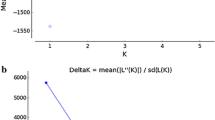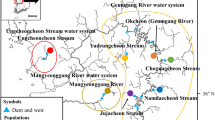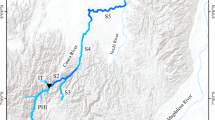Abstract
Microsatellite DNA marker analysis was carried out to assess the population genetic structure of an endangered carp, Labeo calbasu, collected from three different stocks; the Jamuna River, the Halda River and a Hatchery. Four heterologous microsatellite loci (Lr12, Lr14b, Lr21 and Lr24) identified from rohu (Labeo rohita) were analyzed to test the genetic variability of the target kalibaus stocks. The maximum number of alleles observed in loci Lr12, Lr14b, Lr21 and Lr24 were 10, 7, 8 and 6, respectively. The loci were found to be polymorphic (<P 95) in all the populations. The average number of allele was highest in the Jamuna population (6.75) followed by that of the Halda (5.50) and the Hatchery population (4.25). The observed average heterozygosity (Ho) value was almost similar in all three populations. Except locus Lr12 in the Halda population, significant deviations from the Hardy-Weinberg Equilibrium were detected in all cases due to excess heterozygosity. The population differentiation values (F ST ) between all the population pairs were significant. The highest genetic distance value (D = 0.295) was measured between the Halda and the Hatchery populations. A recent bottleneck was observed in the Halda and the Hatchery population.
Similar content being viewed by others
References
Alam MS and Islam MS (2005) Population genetic structure of Catla catla (Hamilton) revealed by microsatellite DNA markers. Aquaculture 246: 151–160.
Alam MS, Jahan M, Hossain MM and Islam MS (2009) Population genetic structure of three major river populations of rohu, Labeo rohita (Cyprinidae; Cypriniformes) using microsatellite DNA markers. Genes Genomics 31: 43–51.
Ali ML and Islam MZ (1998) An assessment of the economic benefits from stocking seasonal floodplains in Bangladesh. In: Pert, T. (ed.). Inland fishery enhancements. FAO Fish. Tech. Pap. 374: 289–303
Cornuet JM and Luikart G (1996) Description and power analysis of two tests for detecting recent population bottlenecks from allele frequency data. Genetics 144: 2001–2014.
Crooijmans RPMA, Vander PJJ, Groenen MAM, Bierbooms VAF and Komen J (1997) Microsatellite markers in common carp (Cyprinus carpio L.). Anim. Genet. 28: 129–134.
Das P, Barat A, Meher PK, Ray PP and Majumdar D (2005) Isolation and characterization of polymorphic microsatellites in Labeo rohita and their cross species amplification in related species. Mol. Ecol. Notes 5: 231.
Excoffier L, Laval G and Schneider S (2005) ARELEQUIN ver.3.0: An integrated software package for population genetics data analysis. Evol. Bioinformat. Onl. 1: 47–50.
Froese R and Pauly D (2009) FishBase. World Wide Web electronic publication. www.fishbase.org, version (10/2009).
Islam MN, Islam MS and Alam MS (2007) Genetic structure of different populations of walking catfish (Clarias batrachus L.) in Bangladesh. Biochem. Genet. 45: 647–662.
Islam MS and Alam MS (2004) Randomly amplified polymorphic DNA analysis of four different populations of the Indian major carp, Labeo rohita (Hamilton 1822). J. Appl. Ichthyol. 20: 407–412.
IUCN (2000) Red Book of Threatened Fishes of Bangladesh. Islam MA, Ameen M and Nishat A, Eds, The World Conservation Union, Dhaka, Bangladesh.
Jackson TR, Martin-Robichu DJ and Reith ME (2003) Application of DNA markers to the management of Atlantic halibut (Hippoglossus hippoglossus) broodstock. Aquaculture 220: 245–259.
Jarne P and Lagoda JL (1996) Microsatellites, from molecules to populations and back. Trends Ecol. Evol. 8: 285–288.
Mia MY, Taggart JB, Gimour AE, Gheyas AA, Das TK, Kohinoor AHM, Rahman MA, Sattar MA, Hussain MG, Mazid MA, et al. (2005) Detection of hybridization between Chinese carp species (Hypophthalmichthys molitrix and Aristichthys nobilis) in hatchery broodstock in Bangladesh, using DNA microsatellite loci. Aquaculture 247: 167–273.
Naish KA and Skibinski DOF (1998) Tetranucleotide microsatellite loci for Indian major carp. J. Fish Biol. 53: 886–889.
Na-Nakorn U, Taniguchi N, Nugroho E, Seki S and Kamonrat W (1999) Isolation and characterization of microsatellite loci of Clarias macrocephalus and their application to genetic diversity study. Fish. Sci. 65: 520–526.
Nash JHE (1991) DNAfrag, Version 3.03. Institute for biological sciences, National Research Council of Canada, Ottawa, Ontario, Canada.
Nei M (1972) Genetic distance between populations. Am. Nat. 106: 283–292.
Oster GF, Shubin N, Maury JD and Alberch P (1988) Evolution and morphogenetic rule: the shape of the vertebrate limb in ontogeny and phylogeny. Evolution 42: 862–884.
Padhi BK and Mandal RK (1995a) Genetic resource mapping and fisheries management. Curr. Sci. 68: 490–493.
Padhi BK and Mandal RK (1995b) Restriction site polymorphism in mitochondrial DNA of Indian major carps. Curr. Sci. 68: 965–967.
Peakall R and Smouse PE (2006) GenAlEx V6: Genetic Analysis in Excel. Population genetic software for teaching and research. Australian National University, Canberra, Australia.
Reynolds J, Weir BS and Cockerham CC (1983) Estimation for the co-ancestry co-efficient: basis for a short term genetic distance. Genetics 105: 767–779.
Sekino M, Hara M and Taniguchi N (2002) Genetic diversity within and between hatchery strains of Japanese flounder Paralichthys olivaceus assessed by means of microsatellite and mitochondrial DNA sequencing analysis. Aquaculture 213: 101–122.
Tave D (1993) Genetics for fish hatchery managers (second edition). AVI, Westport, Connecticut, 415 pp.
Was A and Wenne R (2002) Genetic differentiation in hatchery and wild sea trout (Salmo trutta) in the Southern Baltic at microsatellite loci. Aquaculture 204: 493–506.
Yue GH, Kovacs B and Orban L (2003) Microsatellites from Clarias batracus and their polymorphism in seven additional catfish species. Mol. Ecol. 3: 465–468.
Zhou J, Wu Q, Wang Z and Ye Y (2004) Genetic variation analysis within and among six varieties of common carp (Cyprinus carpio L.) in China using microsatellite markers. Russ. J. Genet. 40: 1144–1148.
Author information
Authors and Affiliations
Corresponding author
Rights and permissions
About this article
Cite this article
Saha, D., Nahiduzzaman, M., Akter, S. et al. Bottleneck in the endangered kalibaus, Labeo calbasu (cyprinidae: cypriniformes) populations in Bangladesh revealed by microsatellite DNA marker analysis. Genes Genom 32, 47–53 (2010). https://doi.org/10.1007/s13258-010-0798-7
Received:
Accepted:
Published:
Issue Date:
DOI: https://doi.org/10.1007/s13258-010-0798-7




